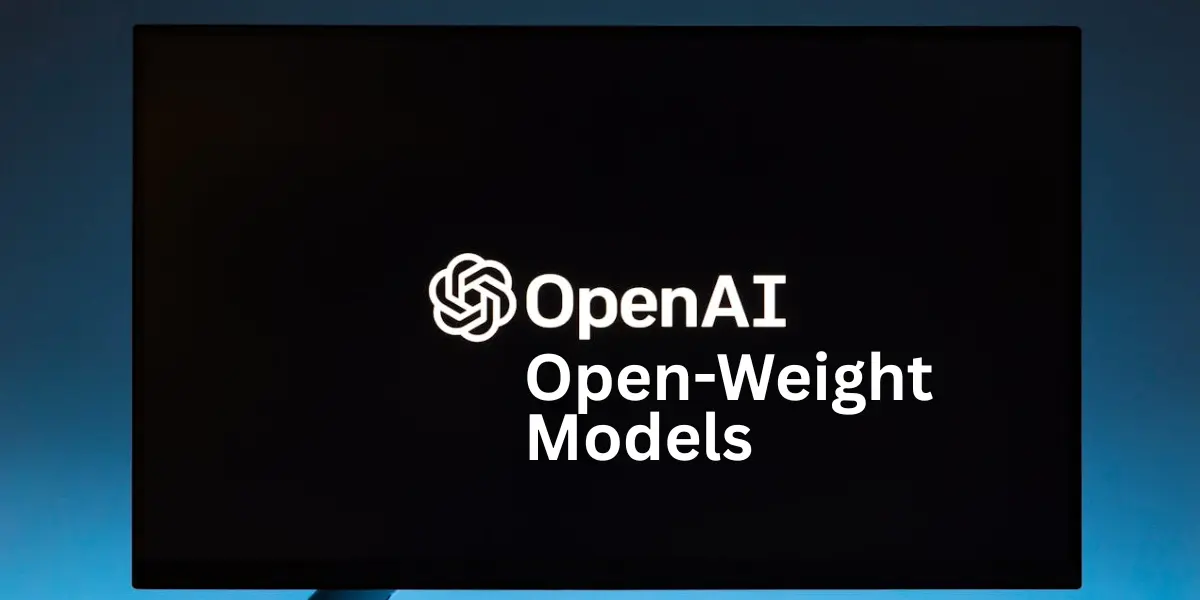OpenAI recently unveiled two open-weight models, gpt-oss-120b and gpt-oss-20b. These releases mark a significant shift since their last open model, GPT-2.
Available under the Apache 2.0 license, they allow free use, modification, and commercial deployment. This move enhances accessibility for developers and businesses.
Gpt-oss-120b and Gpt-oss-20b
The gpt-oss-120b is a 117-billion-parameter model with 5.1 billion active per token. It excels in high-reasoning tasks like coding and agentic workflows.
It rivals OpenAI’s o4-mini on benchmarks such as MMLU and Codeforces. The model runs efficiently on a single 80GB GPU, like NVIDIA H100.
The gpt-oss-20b, with 21 billion parameters, activates 3.6 billion per token. It’s optimized for low-latency tasks and requires only 16GB of memory.
It matches o3-mini performance and suits AI PCs, laptops, or smartphones. Both models use a Mixture-of-Experts (MoE) architecture for efficiency.
They support a 128K token context window. Techniques like chain-of-thought reasoning and sparse/dense attention enhance their capabilities.
Key Features of OpenAI’s Open-Weight Models

Permissive Licensing: The Apache 2.0 license allows broad use and redistribution. This contrasts with Meta’s restrictive Llama licenses.
Customizability: Developers can fine-tune models for specific domains like healthcare or legal. The gpt-oss-20b supports consumer hardware fine-tuning.
Local Deployment: Both models enable on-premises or cloud-based hosting. This ensures data privacy for sensitive applications.
Configurable Reasoning: System prompts allow adjusting reasoning effort (low, medium, high). This balances speed and response depth.
Safety Measures: OpenAI conducted rigorous safety testing, including adversarial fine-tuning. A red-teaming challenge for gpt-oss-20b offers up to $500,000 for exploit discovery.
These features make the models versatile for startups, researchers, and enterprises. They foster innovation while addressing privacy and customization needs.
Accessing and Deploying the Models
Availability: Models are downloadable from Hugging Face or GitHub. Frameworks like PyTorch, Triton, Metal, vLLM, and Ollama support them.
They’re also available on Amazon Bedrock and SageMaker JumpStart in select AWS regions. Unlike OpenAI’s proprietary models, these aren’t API-based.
Hardware Requirements: The gpt-oss-120b needs a high-end GPU (80GB or 60GB VRAM with multiple GPUs). The gpt-oss-20b runs on 16GB memory devices.
Setup Example: Using Hugging Face’s Transformers library, developers can deploy easily. Here’s a sample code for gpt-oss-120b:
from transformers import pipeline
import torch
model_id = "openai/gpt-oss-120b"
pipe = pipeline("text-generation", model=model_id, torch_dtype="auto", device_map="auto")
messages = [{"role": "user", "content": "Explain quantum mechanics clearly."}]
outputs = pipe(messages, max_new_tokens=256)
print(outputs[0]["generated_text"][-1])
Detailed guides are available on OpenAI’s Cookbook and Hugging Face. These resources simplify setup for various platforms.
Why Open-Weight Models Matter
OpenAI’s release counters competition from Meta’s Llama and Mistral’s models. It aligns with U.S. efforts to lead in open AI development.
Developers gain access to state-of-the-art models without API costs. This democratizes AI innovation for startups and researchers.
Local deployment ensures data sovereignty for sensitive sectors. Industries like healthcare and government benefit significantly.
The models enable cost-effective scaling for businesses. They reduce reliance on proprietary cloud-based AI services.
Geopolitically, this strengthens U.S. AI leadership. It counters China’s open models like DeepSeek’s R1.
OpenAI’s move signals a return to its open-source roots. It fosters a transparent and innovative AI ecosystem.
Limitations and Challenges
Hallucination Risks: Early tests show higher-than-expected hallucination rates. This can affect reliability in critical applications.
Not Fully Open-Source: Training data and full architecture details remain proprietary. This limits transparency for some developers.
Safety Concerns: Open-weight models can be modified by bad actors. Developers must implement robust safeguards.
Text-Only Limitation: The models lack multimodal support (e.g., images or audio). This restricts their use in certain applications.
Despite these challenges, OpenAI’s safety testing mitigates risks. Developers are encouraged to add application-specific guardrails.
Strategic Implications for AI Development
OpenAI’s open-weight models reshape the AI landscape. They empower developers to build custom solutions without restrictive licensing.
The release responds to competitive pressures from open models. It positions OpenAI as a leader in accessible AI technology.
Startups can leverage these models for innovative applications. Enterprises benefit from cost-efficient, private AI deployments.
The models support U.S. geopolitical goals in AI dominance. They provide “democratic AI rails” for global developers.
However, balancing openness with safety remains critical. OpenAI’s red-teaming efforts aim to address potential misuse.
How to Get Started with gpt-oss Models
Download models using Hugging Face’s CLI: huggingface-cli download openai/gpt-oss-120b. Alternatively, access them on GitHub.
Use frameworks like vLLM or Ollama for efficient inference. These support both consumer and enterprise hardware.
Check OpenAI’s GitHub repo for deployment guides. Hugging Face offers tutorials for fine-tuning and optimization.
Developers can adjust model parameters for specific tasks. This flexibility suits diverse use cases like coding or research.
For cloud deployment, AWS Bedrock provides seamless integration. Ensure compliance with local data regulations.
Future Outlook for Open-Weight AI
OpenAI’s release sets a precedent for open-weight model adoption. It encourages other organizations to follow suit.
Developers can expect more frameworks to support these models. This will simplify integration and deployment.
Customized AI solutions will proliferate across industries. Healthcare, education, and finance will see tailored applications.
Safety and ethics will remain focal points. Collaborative efforts will be needed to address misuse risks.
Open-weight models could reduce AI development costs globally. This fosters innovation in resource-constrained regions.
Conclusion
OpenAI’s gpt-oss-120b and gpt-oss-20b redefine AI accessibility. They empower developers with flexible, high-performance tools.
Despite challenges like hallucinations, their impact is profound. They drive innovation, privacy, and geopolitical strategy.
Visit OpenAI’s gpt-oss website or Hugging Face for resources. Start building with these models to unlock AI’s potential.

Leave a Reply